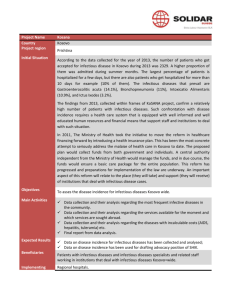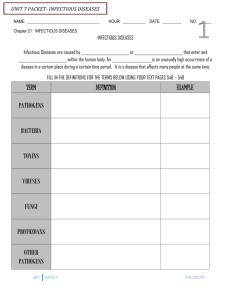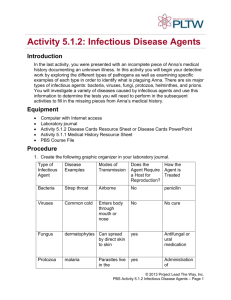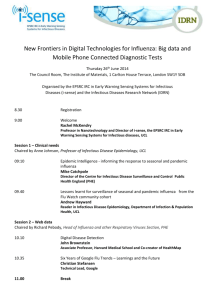6-8
advertisement
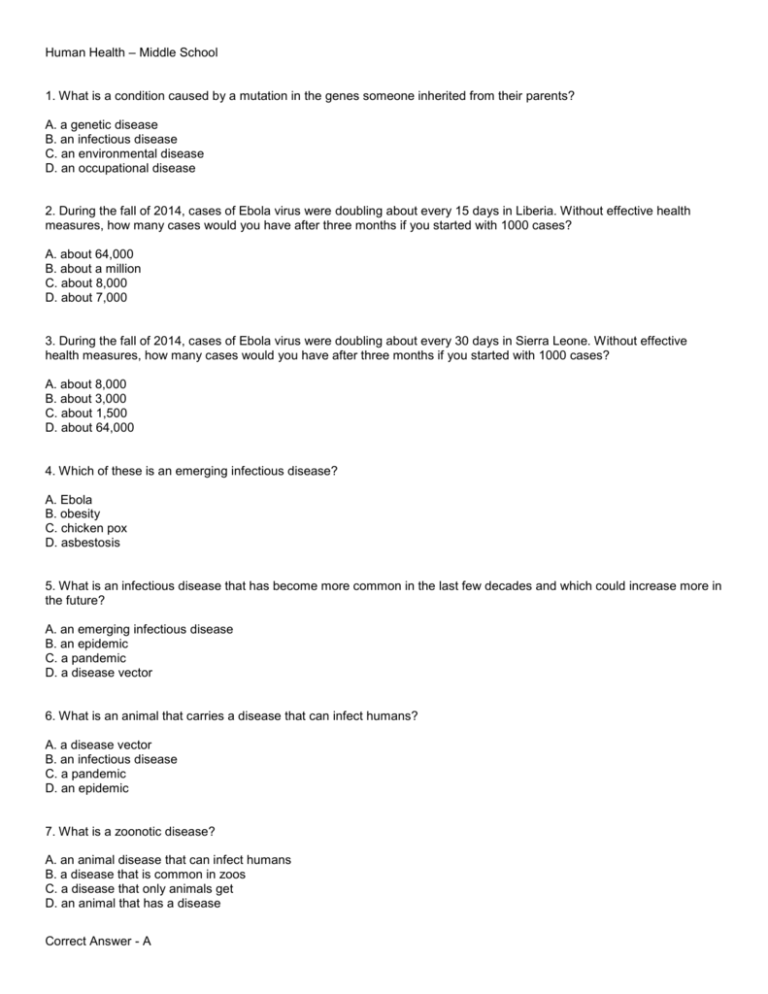
Human Health – Middle School 1. What is a condition caused by a mutation in the genes someone inherited from their parents? A. a genetic disease B. an infectious disease C. an environmental disease D. an occupational disease 2. During the fall of 2014, cases of Ebola virus were doubling about every 15 days in Liberia. Without effective health measures, how many cases would you have after three months if you started with 1000 cases? A. about 64,000 B. about a million C. about 8,000 D. about 7,000 3. During the fall of 2014, cases of Ebola virus were doubling about every 30 days in Sierra Leone. Without effective health measures, how many cases would you have after three months if you started with 1000 cases? A. about 8,000 B. about 3,000 C. about 1,500 D. about 64,000 4. Which of these is an emerging infectious disease? A. Ebola B. obesity C. chicken pox D. asbestosis 5. What is an infectious disease that has become more common in the last few decades and which could increase more in the future? A. an emerging infectious disease B. an epidemic C. a pandemic D. a disease vector 6. What is an animal that carries a disease that can infect humans? A. a disease vector B. an infectious disease C. a pandemic D. an epidemic 7. What is a zoonotic disease? A. an animal disease that can infect humans B. a disease that is common in zoos C. a disease that only animals get D. an animal that has a disease Correct Answer - A Human Health – Middle School 8. What is an infectious disease that spreads to a large number of people across many countries and continents? A. a pandemic B. an epidemic C. an emerging infectious disease D. a zoonotic disease 9. What is an infectious disease that spreads to a large number of people in a short period of time in one location? A. an epidemic B. a pandemic C. an emerging infectious disease D. a disease vector 10. What is a condition caused by a foreign organism getting into someone, where it interferes with how the body works and reproduces and spreads to someone else? A. an infectious disease B. an environmental disease C. a genetic disease D. an occupational disease 11. The Body Mass Indicator, or BMI, is a tool for estimating an adult's body fat using their weight and height. In English units formula is: BMI = ( lbs / inches^2) x 703 . A person with a BMI less than 18.5 is considered underweight, one with a BMI between 18.5 and 24.9 is considered normal, one with a BMI between 25 and 29.9 is considered overweight, and one with a BMI over 30 is considered obese. What category would an adult who weighed 200 lbs and was 70" tall fall into? A. overweight B. obese C. underweight D. normal 12. The Body Mass Indicator, or BMI, is a tool for estimating an adult's body fat using their weight and height. The metric formula is: BMI = ( kg / m^2) . A person with a BMI less than 18.5 is considered underweight, one with a BMI between 18.5 and 24.9 is considered normal, one with a BMI between 25 and 29.9 is considered overweight, and one with a BMI over 30 is considered obese. What category would an adult who weighed 54 kg and was 1.5 m tall fall into? A. normal B. underweight C. overweight D. obese 13. Which of these is a lifestyle disease? A. obesity B. Ebola C. mental retardation D. asbestosis Correct Answer - A Human Health – Middle School 14. What is a condition caused by a person eating too much unhealthy food, not getting enough exercise, and/or using addictive drugs? A. a lifestyle disease B. an infectious disease C. an environmental disease D. a genetic disease 15. What is a condition caused by a mutation in a cell's genes that causes the cell to change, to reproduce uncontrollably and to interfere with how the body works? A. cancer B. a genetic disease C. an environmental disease D. an occupational disease 16. Which of these is an occupational disease? A. asbestosis B. obesity C. Ebola D. chicken pox 17. What is a condition caused by exposure to dangerous conditions or toxic substances in a work situation? A. an occupational disease B. an infectious disease C. a lifestyle disease D. cancer 18. Which of these is caused by mercury poisoning? A. mental retardation B. chicken pox C. Ebola D. asbestosis 19. What is a condition caused by a toxic substance getting into someone and then interfering with the growth, development or function of the body? A. an environmental disease B. an infectious disease C. a genetic disease D. an occupational disease 20. Who plans for and protects the public against outbreaks of diseases? A. public health officers B. zoologists C. health educators D. virologists or microbiologists Correct Answer - A Human Health – Middle School 21. Who helps people understand their disease and the choices they can make to get better? A. health educators B. public health officers C. virologists or microbiologists D. a zoologist 22. Who studies agents of infectious diseases? A. virologists or microbiologists B. health educators C. zoologists D. public health officers 23. Who studies vectors of infectious diseases? A. zoologists B. virologists or microbiologists C. public health officers D. health educators 24. Which federal agency handles surveillance for and tracking of diseases, including those caused by pollutants, and also coordinates the public response to them? A. the Centers for Disease Control (CDC) B. the Food and Drug Administration (FDA) C. the Environmental Protection Agency (EPA) D. the U.S. Department of Agricuture (USDA) 25. Which federal agency is responsible for ensuring that food and beverages, including bottled water, are safe for human consumption? A. the Food and Drug Administration (FDA) B. the Centers for Disease Control (CDC) C. the Environmental Protection Agency (EPA) D. the U.S. Department of Agricuture (USDA) 26. Which federal agency monitors the air, public drinking water systems and soil for heavy metals and toxic compounds? A. the Environmental Protection Agency (EPA) B. the Food and Drug Administration (FDA) C. the Centers for Disease Control (CDC) D. the U.S. Department of Agricuture (USDA) 27. Which federal agency is responsible for ensuring that meat and poultry products have come from healthy animals and do not carry disease? A. the U.S. Department of Agricuture (USDA) B. the Food and Drug Administration (FDA) C. the Environmental Protection Agency (EPA) D. the Centers for Disease Control (CDC) Correct Answer - A Human Health – Middle School 28. Which of these increases the contact between humans and diseases only known from formerly isolated jungles? A. tropical deforestation B. dams, levees and irrigation systems C. Confined Animal Feeding Operations (CAFOs) D. global warming 29. Which of these contributes to increasing antibiotic resistance in bacterial in agricultural settings? A. Confined Animal Feeding Operations (CAFOs) B. global warming C. tropical deforestation D. dams, levees and irrigation systems 30. Which of these contributes to expanding the ranges of tropical diseases and their vectors to higher latitudes and altitudes? A. global warming B. tropical deforestation C. Confined Animal Feeding Operations (CAFOs) D. dams, levees and irrigation systems 31. Which of these contributes to emerging infectious diseases by providing new aquatic habitats for diseases and their vectors to grow? A. dams, levees and irrigation systems B. tropical deforestation C. Confined Animal Feeding Operations (CAFOs) D. antibiotic resistance 32. What is it when bacteria are no longer susceptible to antibiotics? A. antibotic resistance B. pesticide resistance C. vaccination resistance D. an infectious disease 33. What does repeated exposure to antibiotics do in populations of bacteria? A. select for resistance B. change their color C. reduce their size D. nothing 34. What is it when fungi, weeds or insects are no longer affected by a pesticide that used to kill them? A. pesticide resistance B. antibiotic resistance C. vaccination resistance D. heavy metal poisoning Correct Answer - A Human Health – Middle School 35. What does repeated exposure to pesticides do to populations of fungi, weed and insects? A. select for resistance B. change their color C. reduce their size D. nothing 36. DDT is still occasionally used to control the spread of malaria but is no longer as effective as it once was. Why? A. malarial mosquitoes have developed resistance to DDT B. malarial parasites have developed resistance to DDT C. it breaks down to quickly to be of use D. it is too expensive for public health uses Correct Answer - A

